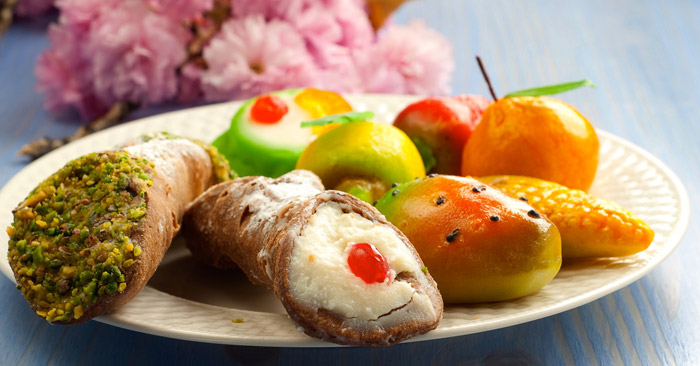Talking about Sicilian food and cuisine means reviving smells and flavours that permeate the island, involving the traveller who visits Sicily. It is impossible not to participate to the taste experience that the Sicilian gastronomy offers with recipes of fish, meat, vegetables, as well as cakes and ice-creams. The essential basis of Sicilian cuisine is the merge of different cultures that influenced the typical smells of the Island. From the Greeks to the Spaniards, passing through the Romans and the Arabs, they all have contributed to influence the Sicilian cuisine, both directly and indirectly. All recipes are characterized by the use of a variety of techniques and seasonings, creating in this way a unique gastronomic experience in which all the Mediterranean tastes meet.

Among the several ways to prepare Sicilian pasta, we can cite “pasta con le sarde” (pasta with sardines) typical of the Palermo area, “pasta ‘ncaciata” (from Messina area) and “pasta alla norma” – with tomatoes, eggplants and salty ricotta cheese (from Catania area). In addition, other specialities are “pane cunzatu” and “pane ca’ mieusa”.
There are specific typical recipes for every area of Sicily. We can find a Greek influence in the eastern side, where the preparation of local dishes is simple and it is common the use of natural products of the earth, like eggplants. On the other hand, the western side of the island was influences by the Arabs, characterized by a great variety of dishes with a longer and more refined preparation.
Caponata di melanzane (an eggplants-based dish) is an example of the special treatment the vegetables need. Or we can also cite “falsomagro” – meat filled with ham, cheese and egg – or “involtini alla palermitana”, filled with breadcrumbs, raisins, pine nuts and cheese, all flavoured with bay and onion.
We can explain the refinement of this kind of cuisine with the flaunting of wealth. In fact the Arabs introduced in Sicily the different types of seasonings used in the recipes, like sugar, citrus fruit, cinnamon, saffron, in addition to rise, used for ”arancini” (fried rice balls coated with breadcrumbs and filled with ragù meat sauce, tomato sauce, mozzarella and peas or ham or cheese), the symbol of Sicilian cuisine. You can taste them in every restaurants and taverns. Furthermore, fish is an important element of the Sicilian cuisine. Tuna has a significant importance, in addition to swordfish, cooked in a large variety of ways. You can find swordfish in every fish market in Sicily, with its large head to peep out in fishmonger’s shops. A particular swordfish preparation is called “alla ghiotta”, with onion, olives, capers and tomatoes. Or you can cook couscous from Trapani with fish and this is a local version of the original couscous recipe from Maghreb (north Africa).
Sicilian pastry deserves a special attention. Pastry is one of the favourite cookery Sicilian habits.
Among the variety of desserts we can cite frutta martorana (marzipan fruit), cannoli and cassata. These desserts have Arabic origin and continued to live thanks to catholic monasteries, which diffused pastry recipes spread all over the Island. We also have to mention the famous Modica chocolate, so good to be exported outside Italy, above all.
And we can’t forget to talk about ice-cream. Apart from the useless discussions if ice-creams origins are Sicilian or not, in this Island you can find delicious tastes and from this point of view Catania, Palermo and Acireale are cities with great cookery tradition. Other delicious flavours of Sicily are related to the large variety of wines, whose great reputation among the wine lovers deserves. So, Sicilian cuisine is really full of flavours, ways of cooking and variety of dishes. It has always been open to the influence of each past ruler of the island.





